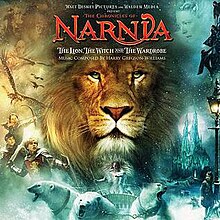The Chronicles of Narnia: The Lion, the Witch and the Wardrobe (soundtrack)
| The Chronicles of Narnia: The Lion, the Witch and the Wardrobe |
||||
|---|---|---|---|---|
 |
||||
| Soundtrack album by Harry Gregson-Williams | ||||
| Released | December 13, 2005 (United States) | |||
| Recorded | September–November 2005 | |||
| Genre | Film score | |||
| Length | 70:44 | |||
| Label | Walt Disney | |||
| Producer | Harry Gregson-Williams, Andrew Adamson, Mike Elizondo | |||
| The Chronicles of Narnia music chronology | ||||
|
||||
| Alternative cover | ||||

Special Edition
|
||||
The Chronicles of Narnia: The Lion, the Witch and the Wardrobe is the soundtrack of the film of the same name. Harry Gregson-Williams composed the soundtrack, which was released on December 13, 2005 (see 2005 in music).
Gregson-Williams was the first composer whom director Andrew Adamson approached for the film because they had worked together on Shrek (2001) and Shrek 2 (2004). Because Adamson had to shoot the film in New Zealand for an extended period and Gregson-Williams was working on scores for films such as Kingdom of Heaven, he initially only prepared for the project by re-reading the book and reading the film script. It wasn't until he saw the first cut of the film that, as he put it, "I could see the look of it, the look of the characters. I found that what I felt emotionally, when compared to the book, was quite different and it was then at that point that I could really 'get under the skin' of the project." He said that although re-reading the book helped him enter "that headspace", the script also provided "a lot of good information" because it included several scenes that weren't in the book.
During the recording process, Gregson-Williams employed the 75-piece Hollywood Studio Symphony Orchestra, along with a 140-member choir (from Abbey Road Studios, London, England; mostly members of the Bach Choir) and numerous other solo musicians such as electric violinist Hugh Marsh and vocalist Lisbeth Scott (at his Wavecrest Studio). He composed the original score and then spent late September through early November 2005 conducting the Hollywood Orchestra and overseeing the recording of the English choir. For "color", he employed instruments used in ancient folk music, and to underscore critical dramatic moments, he added choral textures and, occasionally, a solo voice. The score includes instances of electronic music.
...
Wikipedia
